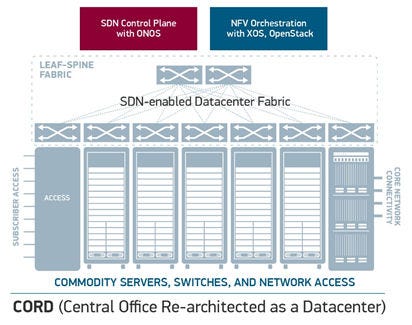CORD domination: overcoming barriers to adoption
CSPs have fully embraced the move to networks built with open source building blocks to drive costs out of their network, accelerate innovation and break vendor lock-in.
August 7, 2017

Telecoms.com periodically invites expert third parties to share their views on the industry’s most pressing issues. In this piece Rizwan Mir, Senior Director, Product Line Manager, CORD Solutions and Services at Radisys, looks at what needs to be done for CORD to take off.
Communications service providers around the world are dealing with the influx of network traffic driven by the explosive growth of mobile video and number of mobile devices, OTT services gobbling up network bandwidth and the emerging billion plus IoT device market.
To deal with this increased strain on their networks, service providers are undergoing a significant multi-year transition of their network architectures, from hardware-centric networks designed around purpose-built telecom hardware to software-centric service delivery networks leveraging open source technology, running on open networking and processing platforms.
Since its formation in January 2015, the Central Office Re-architected as a Datacenter project – CORD – has emerged as one of the leading open service innovation platforms today. CORD is a reference architecture for applying Software-Defined Networking (SDN), Network Functions Virtualization (NFV) and cloud technologies to transform the traditional Central Office into telco optimized data centers. What makes CORD unique is that the large majority of its core software is open source. The CORD architecture relies on Open Compute Project (OCP) based hardware, open source software based on OpenStack, ONOS, Docker or XOS, merchant silicon, leaf and spine fabric and white box switches, and disaggregated access technologies.

Communications service providers (CSPs) have fully embraced the move to networks built with open source building blocks to drive costs out of their network, accelerate innovation and break vendor lock-in. And CORD has attracted significant commitment and active participation from the CSPs in collaboration with established and emerging vendors.
But while it has the support of tier-one CSPs, there are still barriers that must be overcome. And maybe not surprisingly, apprehension is usually at the top of the list. One of the key industry concerns that we have repeatedly heard from these CSPs is around the culture change that needs to take place within their organizations as they seek to embrace DevOps, CI/CD (continuous integration/continuous deployment), and test automation methodologies that are needed when transitioning to CORD.
Potential Barriers to CORD Adoption
Support. CSPs have ongoing concerns about adopting open source software in their mission-critical networks. Unlike in a traditional platform solution delivered by a single vendor, CORD open source contributions come from many sources. CSPs are asking – who will support?
Security. CSPs must ensure that an open source software implementation will address their network security requirements.
Skillsets. Transitioning to software-centric service delivery platforms and architectures is often very new for CSPs – that might have limited resources or expertise in these new technology areas. Until these skillsets are in-house, CORD adoption could be difficult without outside support.
Scalability. The CORD model has been proven in early small proof-of-concept deployments. However, it’s a much bigger challenge to harden and scale CORD to thousands of Central Offices that are common in today’s mobile networks.
Integration. CSPs have many legacy OSS and BSS systems, and they most likely have their own technology and architecture strategy that may not be perfectly aligned with CORD. Integrating CORD into existing Central Office environments could be burdensome.
Surmounting the Barriers – Systems Integrators Lead the Way
In feedback gathered from the tier-one CSPs, many of them believe that their traditional network equipment providers don’t have full expertise in the DevOps model or in creating customized open source tools and automation methodologies to overcome these barriers. In response, we believe that that collaboration between CSPs and vendors is critical as they work together to deliver turnkey CORD reference solutions. And we believe that Systems Integrators will take a leading role in delivering these turnkey solutions that meet CSPs’ specialized requirements.
Systems integrators for CORD need to have an intimate understanding of software architecture and DevOps in addition to traditional network services skills. There are four principles for adapting DevOps ideas to CORD and overcoming the barriers to its adoption. These DevOps principles include:
Deploy with repeatable, reliable processes. Systems integrators must build, orchestrate and deploy processes that are identical in the development, test and production environments.
Develop and test against production-like systems. This includes the verification and debugging of the code in systems that are extremely similar to the production environment where the code will ultimately be deployed.
Monitor and validate operational quality with automated monitoring tools. Deliver tools that verify and validate the operational quality of the service in line with established procedures.
Amplify feedback loops. Systems integrators deploy a common set of tools and APIs that are aimed at providing a common nomenclature for both developers and operators, while simplifying the reproduction of problematic situations in the development, test and operations environments.
For deployment scenarios where a CSP has unique functional requirements, or technology choices outside the CORD reference architecture, systems integrators can develop any custom software or integration support as needed. For example, a systems integrator could integrate with an existing SDN controller, rather than use CORD ONOS.
The Infrastructure of the (Near) Future.
While many CSPs and vendors in the industry believe that CORD provides a thorough reference for deploying service innovation platforms, systems integrators can help deliver flexibility to accommodate the technology choices for each CSP This helps mitigate CSPs’ risk in deploying CORD and accelerates their ability to offer improved service agility and new service innovations – all with a lower cost structure. With the help of systems integrators and the DevOps approach, CORD domination is here to stay.
 Rizwan Mir serves as senior director, product line manager for Radisys’ CORD Solutions and Services. He brings more than 20 years expertise in software and professional services, with cross domain expertise in mobile wireless, SDN/NFV, Cloud, IoT and cybersecurity. At Radisys, he leads efforts in Central Office Rearchitected as a Datacenter (CORD) Solutions and Professional Services to help communications service providers transform their networks using open source software and open compute platforms. Prior to Radisys, Mir held leadership positions at Ericsson and Alcatel-Lucent. He has an MBA in Management Sciences from Benedictine University and an MSc in Wireless Data Networks from The Ohio State University.
Rizwan Mir serves as senior director, product line manager for Radisys’ CORD Solutions and Services. He brings more than 20 years expertise in software and professional services, with cross domain expertise in mobile wireless, SDN/NFV, Cloud, IoT and cybersecurity. At Radisys, he leads efforts in Central Office Rearchitected as a Datacenter (CORD) Solutions and Professional Services to help communications service providers transform their networks using open source software and open compute platforms. Prior to Radisys, Mir held leadership positions at Ericsson and Alcatel-Lucent. He has an MBA in Management Sciences from Benedictine University and an MSc in Wireless Data Networks from The Ohio State University.
Read more about:
DiscussionAbout the Author
You May Also Like












_1.jpg?width=300&auto=webp&quality=80&disable=upscale)
